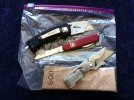In the scythe world, American, English, and Nordic scythes have quite hard blades, while continental European ones are only about as hard as a made-in-Mexico hardware store axe, and are beveled periodically by peening the edge with a specialized hammer and anvil to draw it out. Euro blades often see benefit from extremely fine natural stones that do almost nothing to American blades.
What I am eyeing the Black Ark for are these :
SAK with super reprofiled edge extra acute for cutting very soft materials using oil on the material and blade to give a very professional looking finish.
and
two box knives also reprofiled and polished edge (pretty much).
On the little one I have been experimenting with a toothy edge stropped on the hunk of leather shown with 600 diamond paste ON THE SMOOTH SIDE the label shown is on the back.
I had hopes for my Spyderco Triangle rod Ulta Fine for use on these squishy blades in the photo but that tends to not only form a bur but then not be able to take it off even going edge leading.
I hate stropping so I am always on the look out for a stone that will debur for me instead.
As you said the harder edges respond differently than softer edges. It is way over in left field but I was shocked to find the diamond on the strop did NOTHING for my ceramic knife. For that I have had at least passible improvement on SiC wet or dry paper. Some day I will get back to focusing on learning to sharpen Ceramic blades.
For now I want a highly portable / small tool to touch up several soft bladed tools at work. Some of them shown in the photo . . . there are others.
When will we just be able to get M4 in all blades and I can simply just use my nice Spyderco Ultra Fine . . . works perfect for M4. Life could be so simple.
Call me : The Dreamer
PS: for anyone saying "that black handled Gerber box knife sucks; the blade pops out" I say . . . not if you pean the crap out of the holder until the blade is all but not removable

. All the more reason to strop / touch up. I simply love this box knife once I did that. Super great clip (will even clip to a thick tool belt or bag) and the handle is reminiscent of a Griptillian but even better (has rubberized surface)





